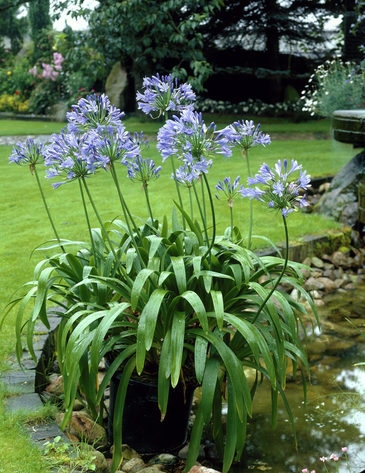Understanding the Art of Agapanthus Treatment: Necessary Steps for Healthy Growth and Vibrant Blooms
In the world of gardening, the growing of agapanthus stands as a gratifying venture for those that seek to nurture these classy flowering plants. From selecting the right variety to understanding trimming techniques, the trip towards cultivating prospering agapanthus plants is multifaceted and holds the crucial to unlocking the full potential of these organic treasures.

Choosing the Right Agapanthus Range

When choosing the right Agapanthus selection for your garden, take into consideration aspects such as climate suitability, blossom color, and growth routine. Furthermore, consider the environment in your area to make sure the Agapanthus selection you pick can flourish in your details problems. Understanding the growth habit of different Agapanthus varieties is vital for proper placement within your garden.
Perfect Planting Conditions
Considering the optimum ecological needs is essential for successful Agapanthus farming. Agapanthus prospers in well-draining soil with a somewhat acidic to neutral pH level. When growing, pick a location that receives full sunshine to partial shade. In hotter environments, offering some afternoon color can avoid scorching of the leaves. Agapanthus plants are delicate to cold temperature levels and need to be protected from frost during wintertime months.
To make sure healthy and balanced development and lively blooms, plant Agapanthus light bulbs at a depth of concerning 2-4 inches and area them 8-12 inches apart. Including raw material, such as compost, to the dirt can enhance drain and fertility, advertising robust origin advancement. Mulching around the base of the plants aids preserve wetness and reduces weed development. Normal watering is vital, specifically throughout the growing season, to keep the soil continually wet however not waterlogged.
Watering and Fertilizing Tips
Preserving proper wetness levels and supplying crucial nutrients are vital elements in the treatment regimen for Agapanthus plants. It is vital to strike a balance when it comes to sprinkling Agapanthus. These plants like constantly moist soil however are at risk to root rot if overwatered. During the expanding season, water deeply when a week, ensuring the soil is well-draining to avoid waterlogging. In hotter climates or throughout original site durations of dry spell, more regular watering may be essential to maintain the soil uniformly moist. Nevertheless, lower watering in the winter season to stop waterlogged conditions.
Feeding Agapanthus is crucial for advertising healthy and balanced growth and prolific flowers. Apply a well balanced plant food, such as a 10-10-10 formula, in the very early springtime as brand-new development arises. By complying with these watering and fertilizing tips, you can ensure your Agapanthus plants thrive and create vibrant, durable blossoms.
Pruning Techniques for Agapanthus
Pruning Agapanthus plants at the ideal times and with correct techniques is vital for maintaining their health and promoting optimum growth and blooming. The perfect time to trim Agapanthus is in late wintertime or early spring prior to new growth emerges. Beginning by removing any type of yellowing or dead leaves near the base of the plant. Cut them as short as possible without damaging the arising shoots.
Deadheading spent blossoms can additionally reroute the plant's power into producing more blooms rather than Extra resources setting seeds. If you want to collect seeds for proliferation, leave some blossoms to fully grown and completely dry on the plant.
Remember to make use of tidy, sharp tools to make exact cuts and decrease the danger of presenting diseases. Agapanthus. Regular Website trimming will certainly help maintain your Agapanthus looking healthy and cool while making sure a plentiful screen of lovely flowers
Taking Care Of Usual Parasites and Conditions
After making sure appropriate pruning methods for Agapanthus, it is important to address usual parasites and conditions that can impact the wellness and vigor of these plants. One common insect that affects Agapanthus is the Agapanthus gall midge.
Additionally, Agapanthus plants can experience from origin rot if they are planted in inadequately draining soil. By being vigilant and taking timely activity against insects and conditions, you can help your Agapanthus plants thrive and produce dynamic blossoms. Agapanthus.

Conclusion
In final thought, grasping the art of agapanthus treatment involves selecting the ideal variety, offering excellent planting conditions, appropriate watering and fertilizing, suitable trimming methods, and dealing with typical bugs and conditions. By complying with these vital actions, you can guarantee healthy development and dynamic blooms for your agapanthus plants. Remember to frequently keep an eye on and keep your plants to promote their general wellness and long life.
To make certain healthy growth and vibrant blossoms, plant Agapanthus light bulbs at a depth of regarding 2-4 inches and space them 8-12 inches apart. By complying with these watering and feeding pointers, you can ensure your Agapanthus plants flourish and produce dynamic, lasting blooms.
One common parasite that impacts Agapanthus is the Agapanthus gall midge. In addition, Agapanthus plants can endure from origin rot if they are planted in badly draining dirt. By complying with these essential steps, you can make certain healthy and balanced development and vivid blooms for your agapanthus plants.